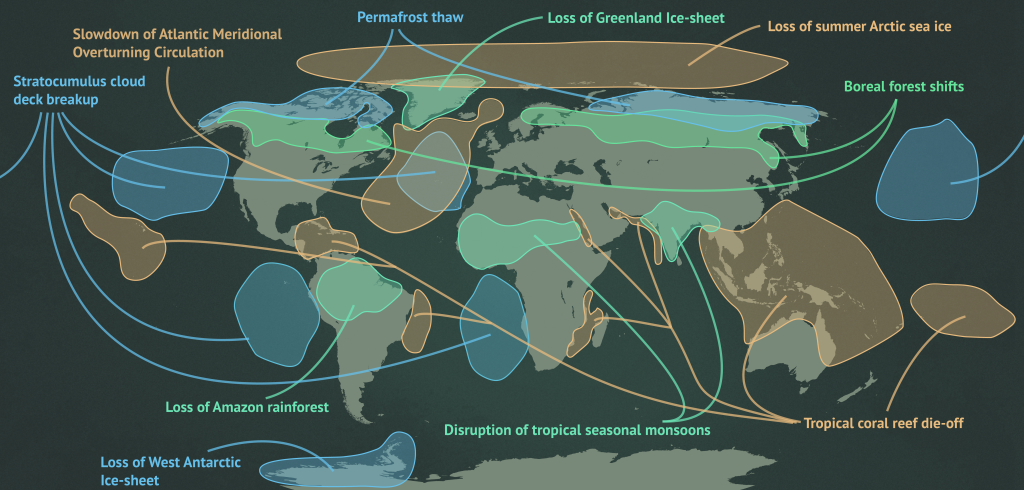Down To Earth (April 01-15-2024)
Climate Migration and Refugees
Context:
- Seven decades after the world defined refugees, it still lacks a definition for climate refugees
About:
- Climate change is increasingly being recognized as a significant driver of human migration and displacement.
- As the impacts of climate change intensify, more people are being forced to leave their homes in search of safer and more sustainable living conditions.
- Climate Migration refers to the large-scale movement of people due to changes in the environment that adversely affect their living conditions.
- The United Nations High Commissioner for Refugees (UNHCR) estimates that an average of 20 million people are forcibly displaced to other areas in countries all over the world by weather-related events every year.
Impact of Climate Change on Migration:
- Climate change exacerbates existing vulnerabilities, requiring greater support for those on the move and their host communities.
- The majority of people forcibly displaced by persecution, conflict, and violence today live in countries that are highly vulnerable and ill-prepared to adapt to climate change.
- Displaced populations frequently have no option but to live in remote locations, in overcrowded camps or informal settlements, with limited access to basic services or infrastructure and where they are highly exposed and vulnerable to climate hazards like floods, drought, storms, and heatwaves.
Policy Responses to Climate Migration:
- Protection: Strengthen and expand the protection of refugees and migrants in situations of vulnerability affected by climate change.
- Partnerships: Enhance existing climate action by partnering with key humanitarian partners.
- Multilateral Engagement: Expand U.S. multilateral diplomacy and leadership to address the impacts of climate change on migration and displacement in international fora.
- Coordination: Strengthen coordination between agencies to advance policy solutions for refugees and migrants affected by climate change.
Role of International Organizations:
- International organisations like the UNHCR are working to protect displaced people and strengthen their resilience to the current and future impacts of climate change.
- The UNHCR’s Strategic Plan for Climate Action 2024-2030 details a global roadmap for prioritised action in support of governments and in collaboration with a wide range of partners.
- Geneva Convention (1951): It gives a legal definition of refugees. It does not include climate disasters as a ground for seeking asylum
- 1985: UN Environment Programme for the first time broadly defines environmental refugees as people who are forced to leave their traditional habitat, temporarily or permanently, due to ‘environmental disruption’.
- 2011: Nansen Conference on Climate Change and Displacement in Norway formulates 10 principles on climate change and crossborder displacement
- 2013: European Commission downplays climate-induced migration into Europe.
- 2015: The Paris Agreement calls for a taskforce to recommend approaches to avert, minimise and address climate change-related displacement
- 2018: The UN Global Compact on Refugees has a reference of climate refugees, but lacks actionable commitments from countries
- It is the first inter-governmental and non-binding agreement that acknowledges that climate change is a “deep cause” for the movement of people, but is silent on the impacted communities.
- 2022: Kampala Ministerial Declaration on Migration, Environment and Climate Change allows people affected by weather events to move safely across the borders in the Horn and East of Africa regions.
- It was adopted by 48 African countries in 2023 to address the link between climate change and human mobility in the continent, and does not mention the term climate refugee.
- 2023: Pacific island countries agree on a framework to allow cross-border movement of people due to climate change.
- Australia and Tuvalu sign a treaty which allows some people from Tuvalu affected by climate change to migrate to Australia and work there.
- The Global Goal on Adaptation, a significant outcome of the 28th Conference of the Parties to the UNFCCC (COP 28) in 2023, fails to mention climate migration, mobility or refugees.
- The global goal, enshrined under Article 7.1 of the 2015 Paris Agreement, pledges to “enhance [the world’s] adaptive capacity, strengthen resilience, and reduce vulnerability to climate change”.
Conclusion
- Climate migration is a complex and urgent issue that requires coordinated global action.
- By understanding the link between climate change and migration, and by implementing effective policies and strategies, there is a need to ensure the protection and resilience of climate migrants and refugees.
- As the impacts of climate change continue to intensify, addressing climate migration will become an increasingly important part of our global response to the climate crisis.
Context:
- Communities in Chhattisgarh and Uttar Pradesh reduce human-elephant conflicts using technology and proactive on-ground monitoring.
About the Human-Elephant Conflicts in India
- Human-elephant conflict (HEC) has emerged as a significant challenge for elephant conservation and management in India.
- The conflict, characterised by crop raiding, property damage, and loss of human and elephant lives, is escalating due to habitat loss and fragmentation.
Understanding the Conflict
- India is home to a significant population of Asian elephants, with Assam having the second-highest number after Karnataka.
- However, loss of natural habitat and fragmentation have been bringing wild elephants closer to human habitations, sparking conflicts.
- Over 500 humans are killed in encounters with elephants annually, and crops and property worth millions are also damaged.
- Many elephants are also killed in retaliation.
Impact of Conflict
- The conflict creates considerable economic hardships for the affected farmers.
- There are several regions that experience crop damage by elephants year after year. Human deaths due to encounters with elephants are also an issue of serious concern.
- It is estimated that every year approximately 400 persons are killed by elephants across the country, and more than 100 elephants are also killed annually, mostly as retaliatory killings by people.
Government Initiatives
- The Ministry of Environment, Forest and Climate Change (MoEFCC) has released guidelines for the management of HEC.
- These guidelines define HEC and provide measures for preventing the entry of elephants into human-use areas, such as villages and agricultural fields.
- The government has launched a national portal on human-elephant conflict called ‘Surakhsya’ for the collection of real-time information and for managing the conflicts on a real-time basis.
- It aims to help set the data collection protocols, data transmission pipelines, and data visualisation tools to enable policymakers to leverage HEC data for policy formulation and for the preparation of Action Plans for mitigation of conflicts.
Major Elephant Corridors in India
- Elephant corridors are vital for the conservation of elephants as they provide connectivity between different habitats, allowing elephants to move freely and access resources such as food and water.
- They also play a crucial role in maintaining genetic diversity among elephant populations.
State of Elephant Corridors in India
- As per the MoEFCC, the number of elephant corridors in India has increased to 150, up from 88 in 2010.
- It reflects the expansion of elephant ranges in regions such as Vidarbha in Maharashtra, southern Maharashtra bordering Karnataka, northern Andhra Pradesh, and Madhya Pradesh.
- West Bengal has the highest number of elephant corridors, totaling 26, constituting 17% of the total corridors.
- The East central region contributes 35% (52 corridors), and the North East region follows as the second-largest with 32% (48 corridors).
Conclusion
- Human-Elephant Conflict in India is a complex issue that requires a multi-pronged approach for its resolution.
- While efforts are being made at various levels to mitigate the conflict, it is crucial to ensure the protection of both humans and elephants.
- As we move forward, it is hoped that these initiatives will help in reducing the conflict and contribute to the harmonious co-existence of humans and elephants.
Context:
- A study has found that the cities with population above 1 million in 2016, will face water scarcity in 2050.
About the Global Water Scarcity
- Water scarcity is a relative concept, where the demand for water may exceed the supply, or the infrastructure may be inadequate to meet everyone’s needs.
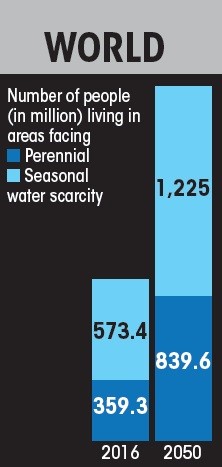
- It is an increasing problem on every continent, with poorer communities most severely affected.
- As the global population increases and climate change intensifies, the availability of freshwater resources is becoming increasingly strained.
- Globally, 2 billion people (26% of the population) do not have safe drinking water, and 3.6 billion (46%) lack access to safely managed sanitation.
- Between two and three billion people experience water shortages for at least one month per year.
- It poses severe risks to livelihoods, notably through food security and access to electricity.
Conditions for Water Availability and Stress
- The natural distribution and availability of water resources is characterised by high or extreme variability, as evidenced by increasing or decreasing river discharge.
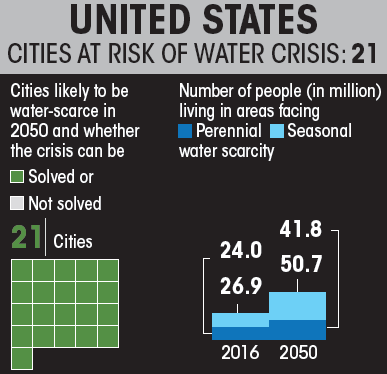



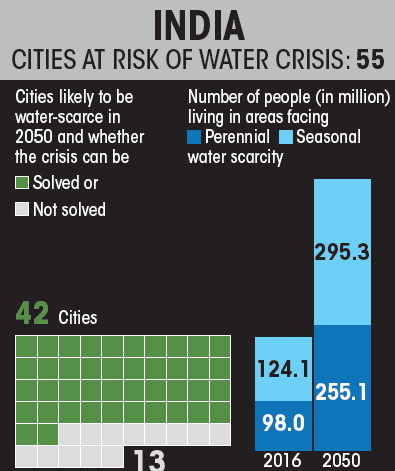
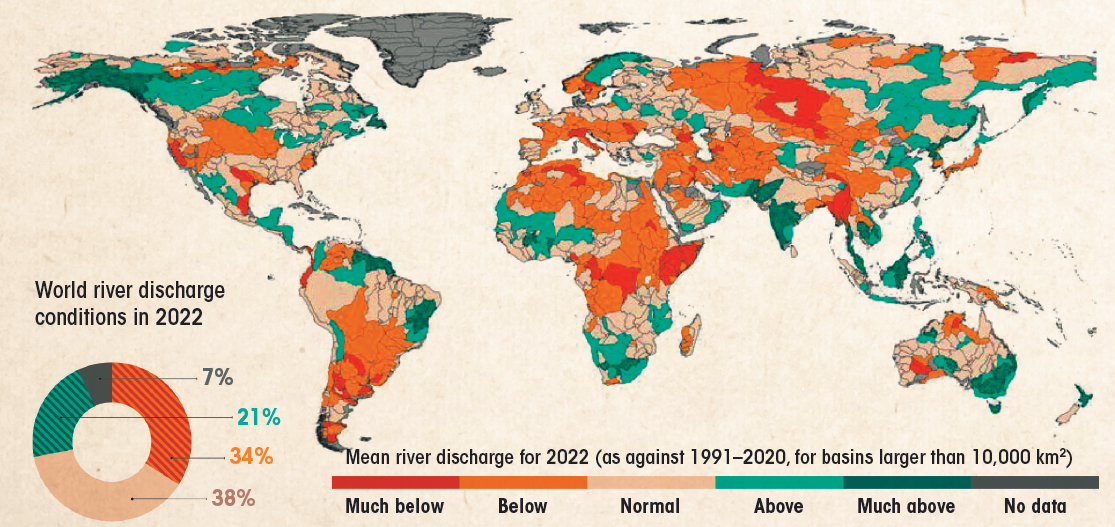
Impact of Climate Change
- Climate change is exacerbating the water scarcity crisis.
- Over the past twenty years, terrestrial water storage – including soil moisture, snow, and ice – has dropped at a rate of 1 cm per year, with major ramifications for water security.
- The global urban population facing water scarcity is projected to double from 930 million in 2016 to 1.7 – 2.4 billion people in 2050.
Drought
- It is one of the major drivers of global food and water insecurity, and has strong links with land use, land use change and resilience.
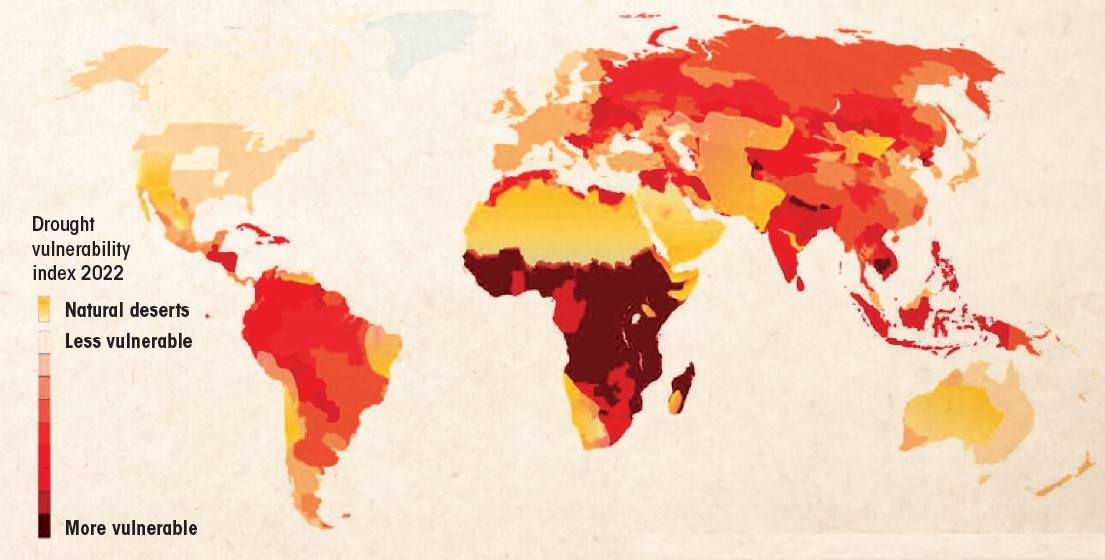
Widespread crisis
- Roughly half of the world’s population sees severe water scarcity, either for a few months or throughout the year.

Human Cost
- Poor and marginalised groups are on the frontline of any water scarcity crisis, impacting their ability to maintain good health, protect their families, and earn a living.
- For many women and girls, water scarcity means more laborious, time-consuming water collection, putting them at increased risk of attack and often precluding them from education or work.
Solutions
- Shared Socioeconomic Pathway-1 (SSP1) and Representative Concentration Pathway-2.6 (RCP2.6), which are the most sustainable development pathway of low climate change mitigation challenges and low social vulnerability, as per IPCC.
- Desalination of Seawater
- Groundwater exploitation
- Reservoir construction
- Inter-basin water transfer
- Domestic virtual water trade
- International water transfer / virtual water trade
Way Forward
- There is an urgent need to establish strong international mechanisms to prevent the global water crisis from spiralling out of control.
- Integrated water resources management (IWRM) provides a broad framework for governments to align water use patterns with the needs and demands of different users, including the environment.
- Data, technology, and communications have a critical role.
- IWRM depends on good quality data on water resources; water-saving, green and hybrid technologies, particularly in industry and agriculture; and awareness campaigns to reduce the use of water in households and encourage sustainable diets and consumption.
Context:
- Current levels of inequality were last seen before 1922, during the British Raj
About the Inequality in India
- Inequality is a multifaceted issue that encompasses income, wealth, and opportunities.
- It is not just about the distribution of wealth but also about access to resources, opportunities, and decision-making power.
- In India, the Periodic Labour Force Survey for the years 2017-18, 2018-19, and 2019-20 shows that the top 10% earn approximately equal to the bottom 64%.
- Over the past few decades, the gap between the rich and the poor has widened significantly, leading to social, economic, and political repercussions.
State of Inequality in India
- According to the World Inequality Lab, by 2022-23, 22.6% of India’s national income went to just the top 1% in the country, the highest in the last 100 years.
- The top 1% of the population held more than a fifth of the national income while the bottom half accounted for a mere 13%.
- It has been reducing for some decades.
- India’s wealth distribution also signals how fast inequality is growing. A household here, on average, had wealth worth Rs 983,010. But the general wealth held by the bottom half was “almost nothing” at Rs 66,280.
- That’s just 6% of the Indian average.
Impact of Inequality
- The rising inequality in India has severe implications.
- It undermines both growth and reduction of poverty.
- Between 1960 and 1980, inequality was dropping.
- However, inequality began increasing with the beginnings of liberalisation in the 1980s, and faster after the 1991 economic reforms in India.
Major Initiatives
- Beti Bachao Beti Padhao (BBBP): It ensures the protection, survival, and education of the girl child.
- Mahila Shakti Kendra: It aims to empower rural women with opportunities for skill development and employment.
- Pradhan Mantri Jan Dhan Yojana (PMJDY): One of the biggest financial inclusion initiatives in the world.
- Pradhan Mantri Matru Vandna Yojna: It aims to provide maternity benefits to pregnant and lactating mothers.
- Pradhan Mantri Kaushal Vikas Yojana (PMKVY): It aims to enable a large number of Indian youth including women to take up industry-relevant skill training in securing a better livelihood.
- Deen Dayal Upadhyay National Urban Livelihoods Mission (DAY-NULM): It focuses on creating opportunities for women in skill development, leading to market-based employment.
- State of Inequality in India Report: It was released by Dr Bibek Debroy, Chairman, Economic Advisory Council to the Prime Minister (EAC-PM).
- It presents a holistic analysis of the depth and nature of inequality in India.
- National Policy for Women Empowerment: It is aimed at securing a better, safe, and equal place for women in society and taking care of their all-round interests including their socio-economic development.
Conclusion
- Inequality in India is a complex issue that requires a multi-pronged approach for its resolution. While efforts are being made at various levels to mitigate the inequality, it is crucial to ensure the protection of both humans and elephants.
- As we face the imminent risk of a global water crisis, it is essential to act together to share water equitably and manage it sustainably
Shifts in Global Weather Patterns
Context:
- A study published in the Weather and Climate Dynamics found that the change in winter and spring weather patterns is likely to get more intense.
Understanding Climate Change
- Global weather patterns are undergoing significant shifts due to climate change.
- Climate change refers to long-term shifts in temperatures and weather patterns.
- These shifts can be natural, due to changes in the sun’s activity or large volcanic eruptions.
- However, the changes observed since the mid-20th century are largely driven by human activities, particularly the burning of fossil fuels.
Impact on Weather Patterns
- The warming of the planet impacts local and regional climates.
- It may cause weather patterns to become less predictable.
- These unexpected weather patterns can make it difficult to maintain and grow crops in regions that rely on farming because expected temperature and rainfall levels can no longer be relied on.
- Widespread changes in weather patterns and increased frequency and severity of extreme weather events are well-documented consequences of global climate change.
- These departures from old norms can bring storms, droughts, heatwaves, and wildfire conditions beyond what infrastructure has been designed to withstand or what people have come to expect.
- Weather and Climate Dynamics reveals that over the past 70 years, western disturbances have been occurring more often during summer, shifting precipitation trends.
- Globally, too, countries have reported extreme seasonal conditions this year, with record breaking temperatures in countries like Indonesia, South Africa, Gabon, Kenya, South Sudan, Algeria, Tunisia, Guyana, Colombia and Brazil.
Rising Sea Levels
- In polar regions, the warming global temperatures associated with climate change have meant ice sheets and glaciers are melting at an accelerated rate.
- It contributes to sea levels rising in different regions of the planet.
- Together with expanding ocean waters due to rising temperatures, the resulting rise in sea level has begun to damage coastlines as a result of increased flooding and erosion.
Atlantic Meridional Overturning Circulation (AMOC)
Context:
- Recently, it was found that the Anthropogenic aerosols, which include pollution from transportation, coal combustion and manufacturing, work to reduce AMOC movement by shielding the solar heating and cooling the Earth's climate.
About:
- It was found that anthropogenic aerosols over North America and Europe, along with rising greenhouse gases, can contribute to a slowdown of AMOC.
- However, it was unclear whether aerosols from Asia could also impact the system.
- In a recent study published in Nature Communications, scientists have found a direct link — an increase in aerosols over Asia could accelerate the risk of an AMOC collapse.
- Another study shows that the AMOC could collapse between 2025 and 2095 due to the impact of anthropogenic emissions.
- If the above prediction deems true, AMOC may be the first of the 16 climate tipping elements to be breached.
|
Atlantic Meridional Overturning Circulation (AMOC):
Tipping elements in the Earth's climate system:
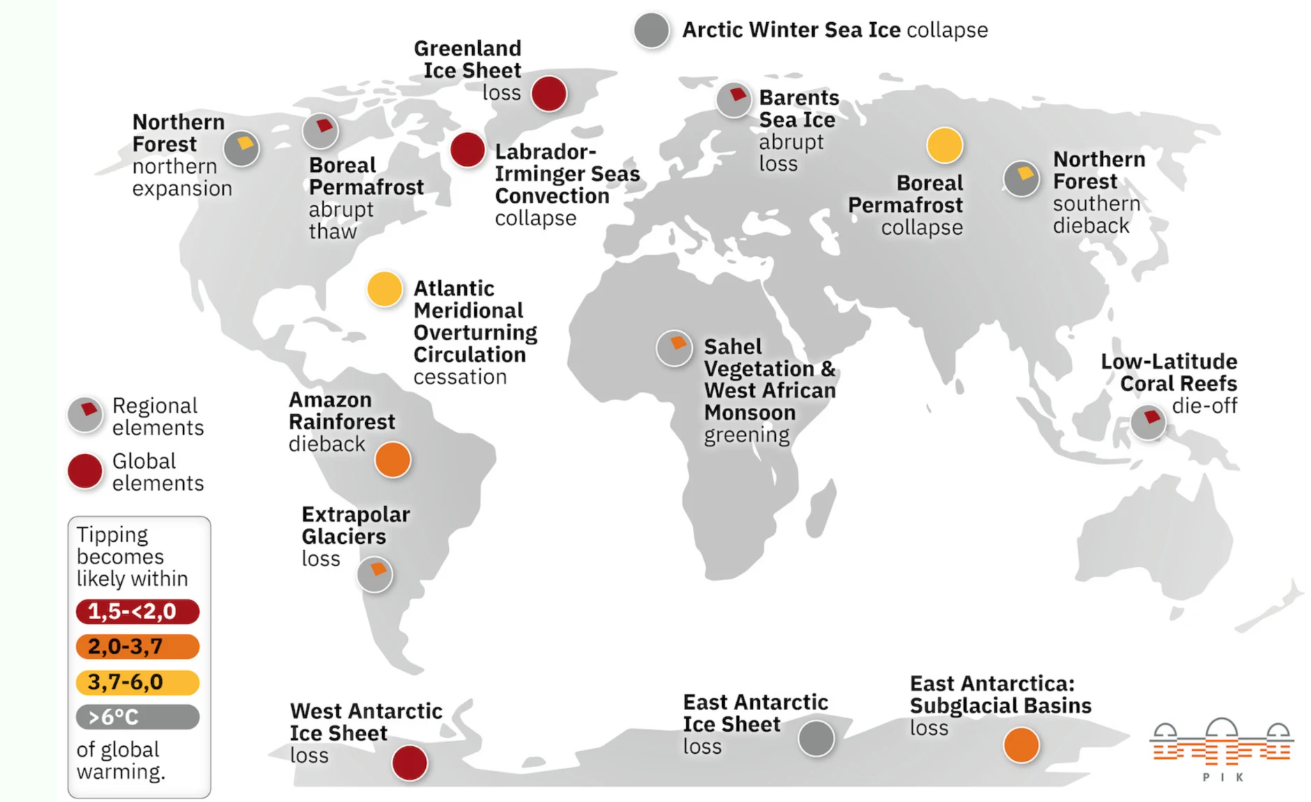 (Fig: Tipping elements) Domino effect:
|
Slowing of AMOC:
- For the past few decades, more fresh cold water has been added to the North Atlantic Ocean due to increased precipitation and rapid melting of the Greenland ice sheet, which is reducing salinity and density of the water. This is slowing down AMOC and will lead to its collapse.
- Data for Sea Surface Temperatures (SSTs) between 1870 and 2020 shows collapse of AMOC in the North Atlantic Ocean (Subpolar gyre) “fingerprint” region is significant.
- Historically, the collapse of AMOC has been associated with warming events. According to paleoclimatic data, in the past before the start of the planet’s glacial periods or ice ages, there was abrupt warming.
- Scientists term these incidents Dansgaard-Oeschger events, which occurred over a few decades before gradual cooling heralds an ice age.
- The UN Intergovernmental Panel on Climate Change (IPCC) in its sixth Assessment Report series estimates that AMOC is unlikely to see a halt this century.
What if AMOC would collapse?
- AMOC is a kind of ‘switch’ for climate in the northern hemisphere, especially Europe.
- It would cause widespread cooling across the northern hemisphere and less precipitation in places such as Europe, North America, China and some parts of Russia in Asia.
- The excess heat due to a collapsed AMOC could lead to less rainfall over the Amazon rainforest and make it drought prone and dry, and it could potentially transform it to a savannah state.
- A slowdown of AMOC could hinder monsoon formation and rainfall in different regions.
- Rainfall in the Sahel region (the West African monsoon) could reduce, the summer monsoon circulation in South Asia and India could weaken; and there might be more winter storms in Europe.
- Weakening of the land-sea thermal gradient weakens the sea level pressure gradient and the summer monsoon circulation over the Indian region.
Context:
- Nearly 2 billion people globally are threatened due to land subsidence, a geohazard caused by the sudden or gradual settling of ground surface.
About the Land Subsidence:
- Land subsidence, the sinking or lowering of the Earth’s surface, is a global geological hazard that poses serious risks to infrastructure, natural resources, built environment, and businesses in numerous places worldwide.
- It is caused by the sudden or gradual settling of the land surface due to the removal of subsurface material.
- It can be due to a variety of factors, both natural (include earthquakes, volcanic activity, and compaction of fine-grained unconsolidated sediments) and anthropogenic (include mining and extraction of groundwater, oil, gas, and minerals).
Land Subsidence Around the World
- It is estimated that by 2040, land subsidence will affect about 8% of the world’s surface and about 1.2 billion inhabitants living in 21% of the major cities worldwide.
- For example, Jakarta in Indonesia is another city experiencing significant land subsidence due to unregulated pumping of groundwater.
- More than 6.3 million sq km of Earth's surface is susceptible to significant subsidence, with the primary reason being groundwater abstraction.

Land Subsidence in India
- In India, land subsidence has become a significant concern, particularly in the capital city, Delhi.
- A recent study shows that parts of Delhi, including Kapashera, an urban village near Delhi’s international airport, and Faridabad, a part of Delhi’s larger metropolitan area, are experiencing dangerous land subsidence.
- The subsidence rate was more than 11 cm/year in Kapashera and 3 cm/year in Faridabad.
- This subsidence is attributed to excessive groundwater extraction.
Impact of Land Subsidence
- Land subsidence reduces the flood-control capacity in urban areas and brings security risk and damage to buildings and a whole range of infrastructure including roads, bridges, rail transits, flood control walls, and underground lines.
- With an increase in land subsidence occurring in densely populated areas, a key factor driving subsidence is groundwater abstraction — the removal of water stored in the pore space of subsurface layers and transporting it away for human consumption and irrigation in agriculture, leading to compaction of the subsurface sediments.
Conclusion
- Land subsidence is a destructive phenomenon that damages infrastructure and aquifers, as well as putting human lives at risk.
- Population growth has played an undeniable part in resource extraction that has led to subsidence.
- Therefore, it is crucial to manage our resources sustainably and implement effective measures to mitigate this geohazard.
- Further research and monitoring are needed to understand the full extent of land subsidence and develop effective strategies to address it.
Context:
- Recently, the US Environmental Protection Agency (EPA) issued a comprehensive ban on Chrysotile Asbestos.
About the Chrysotile Asbestos:
- Chrysotile, commonly known as white asbestos, is a fibrous mineral and one of the six types of asbestos.
- It is the sole form of asbestos in the serpentine group of minerals.
- It is the most commonly encountered form of asbestos, accounting for approximately 95% of the asbestos in the United States and a similar proportion in other countries.
- It is a soft, fibrous silicate mineral in the serpentine subgroup of phyllosilicates.
- Chrysotile boasts properties such as high tensile strength, flexibility, and resistance to heat and chemicals, which once made it a popular choice in construction materials.
Health Risks Associated with Chrysotile Asbestos
- It is clear that chrysotile can cause mesothelioma (cancer of the lung or abdominal cavity linings).
- The relevant primary scientific literature is systematically analysed in several international scientific agency reports.
- All reports document and evaluate the extensive evidence in humans (and animals) and confirm that all forms of asbestos — including chrysotile — are the only known cause of mesothelioma.
- It can also cause other cancers, including the most common cancer associated with asbestos exposure, cancer of the lung, as well as cancer of the larynx and ovaries.
- It is also associated with pharynx, stomach, and cancer.
Pioneers of Green Revolution in India
Context:
- India needs more minds like MS Swaminathan, Ram Dhan Singh, DS Athwal etc to deal with the current issues faced by Indian Agriculture.
About the Green Revolution:
- It was a major initiative to ensure food security globally, with the aim to introduce new technologies such as High-Yielding Varieties (HYVs) of seeds, fertilisers, pesticides, irrigation and mechanisation.
- Its purpose was to alleviate hunger by increasing the production and quality of food crops, especially wheat and rice.
- The main objective was to make the country self-sufficient in food grains by adopting modern agricultural practices.
- It included the use of HYVs seeds, mechanised farm tools, irrigation facilities, pesticides, and fertilisers.
Persons associated with Green Revolution:
- Norman Borlaug is known as the Father of the Green Revolution.
- In 1970, he was awarded the Nobel Peace Prize for his work in developing high yielding dwarf varieties of wheat.
- MS Swaminathan is known as the Father of Green Revolution in India.
- However, from the scientific point of view, it was initiated by Ram Dhan Singh of Punjab Agricultural College, who developed improved wheat varieties such as C-591, and C-306 that provided a high yield without chemical fertilisers and limited irrigation facilities.
- His contribution was appreciated by Borlaug, and C-306 is being cultivated even 80 years after development.
- Chidambaram Subramaniam: As the Food and Agriculture Minister at the time, Subramaniam is often referred to as the 'Political Father of the Green Revolution’.
- In the field of wheat research, notable work has been done by DS Athwal and VS Mathur.
- Athwal worked on rice and developed the world’s first millet hybrid, and is recognized as the ‘Father of the Wheat Revolution’ for his significant contributions to wheat production.
- Others who worked on rice include Gurdev Singh Khush, VP Singh, Dharampal Singh and Rajeev Varshney.
- NGP Rao developed the first sorghum hybrid and CT Patel the first cotton hybrid.
- TS Venkatraman and Janaki Ammal are remembered for their excellent research on sugarcane improvement.
Context:
- The World Health Organization (WHO) found that the resistance to the antiretroviral drug dolutegravir is increasing among HIV patients.
- However, the body now notes evidence of resistance of 3.9-8.6% among patients.
About the Antiretroviral Drugs for HIV:
- Antiretroviral therapy (ART) is a combination of medications used to treat Human Immunodeficiency Virus (HIV).
- It works by stopping HIV from reproducing, which can reduce levels of HIV and keep the immune system healthy.
- Although it’s not a cure, many people reach undetectable levels of HIV with ART.
Understanding Antiretroviral Therapy
- The treatment for HIV is called antiretroviral therapy (ART) that involves taking a combination of HIV medicines (called an HIV treatment regimen) every day.
- ART is recommended for everyone who has HIV, and people with HIV should start taking HIV medicines as soon as possible.
Antiretroviral Drugs
- Antiretroviral drugs are organised into six different classes based largely on the stage of the life cycle they inhibit.
- These include Entry/Attachment Inhibitors, Integrase Inhibitors, Nucleoside Reverse Transcriptase Inhibitors (NRTIs), Non-Nucleoside Reverse Transcriptase Inhibitors (NNRTIs), Protease Inhibitors (PIs), Fusion Inhibitors, and CCR5 Antagonists.
- It includes the first antiretroviral drug regimen, Cabenuva, which requires a once-a-month or once-every-two-month injection rather than an oral dose daily.
Future of Antiretroviral Therapy
- Antiretroviral therapy is quickly changing, with newer drug agents offering fewer side effects, greater durability, and a decreased risk of drug resistance.
- In the past, antiretroviral therapy was described as a three-drug ‘cocktail’.
- Today, with improved pharmacokinetics and a longer drug half-life, antiretroviral therapy may involve as few as two co-formulated drug agents.
First Advance Estimates of Horticultural Crops for 2023-24
Context:
- Recently, the Department of Agriculture and Farmers’ Welfare has released the First Advance Estimates of 2023-24 of Area and Production of various Horticultural Crops.
About:
Overview of the Estimates
- The horticulture production in the country in 2023-24 (First Advance Estimates) is estimated to be about 355.25 Million Tonnes, marginally lower than the 355.48 million tonnes as per the 2022-23 final estimates.
- An increase in area of 1.15% or 3.27 Lakh Ha is observed in 2023-24 over 2022-23 (Final Estimates).
- The estimates provide a comprehensive overview of the expected production and area under cultivation for horticultural crops in India for the year 2023-24.
Fruit Production
- The production of fruits is expected to reach 112.08 Million Tonnes, mainly due to increases in production of Banana, Mandarin, and Mango.
Vegetable Production
- Production of vegetables is envisaged to be around 209.39 Million Tonnes.
- Increase is expected in production of Cabbage, Cauliflower, Pumpkin, Tapioca, Tomato, and Other Vegetables.
Specific Crop Estimates
- Tomato: Production of Tomato is expected to be around 208.19 Lakh Tonne compared to around 204.25 Lakh Tonne last year, an increase by 1.93% Lakh Tonne.
- Onion: Production of Onion in 2023-24 is expected to be around 254.73 Lakh Tonne compared to around 302.08 Lakh Tonne last year due to decrease of 34.31 Lakh Tonne in Maharashtra, 9.95 Lakh Tonne in Karnataka, 3.54 Lakh Tonne in Andhra Pradesh and 3.12 Lakh Tonne in Rajasthan.
- Potato: Production of Potato in 2023-24 is expected to be around 589.94 Lakh Tonne compared to around 601.42 Lakh Tonne last year, attributed to decrease in West Bengal over the previous year.
Context:
- Recently, Tamil Nadu announced the launch of the country's first marine force to protect marine resources and biodiversity in the Gulf of Mannar and the Palk Bay.
About:
- The Marine Elite Force aims to combat marine wildlife crimes, including smuggling, prevention, and poaching of marine animals, particularly in the Gulf of Mannar Biosphere and Palk Bay.
- The force is equipped with two deep water boats with a wireless communication system.
- They have been training for over a year and have been carrying out pilot operations from April 2023.
- It enhances the capacity of the Tamil Nadu Forest Department to conserve marine and coastal ecology in a professional manner but also plays a crucial role in combating illegal wildlife smuggling in the region.
- It sets a precedent for other coastal states in India to follow, thereby contributing to the larger goal of marine conservation.
Team Behind the Force
- Twelve marine watchers have been engaged in the Marine Elite Force from the local fishermen community.
- They have been given extensive training related to marine patrolling, including scuba diving, snorkelling.
- The Marine Watchers have been trained by specialised forces viz. Indian Coast Guard, Navy, and Marine Police.
Impact of the Marine Elite Force
- During the pilot operations, the force has detected 25 cases with the seizure of 4133 Kg of illegal wildlife articles.
- It has been doing vigilant patrolling activities to strengthen the protection and sustainable management of the marine area, build capacity, and collect and disseminate information.
Context:
- Recently, Himachal Pradesh banned the production, sale and storage of cotton candy or candy floss for one year, after tests revealed the presence of a potentially hazardous colouring agent named Rhodamine B in samples.
About the Rhodamine B
- It is a chemical commonly used for dyeing in the textile, paper, leather, and paints industry as a colouring agent that helps in attaining the red and pink spectrum.
- In powdered form the chemical is green in colour and upon being added to water, it turns pink.
- It is being tested for use as a biomarker in oral rabies vaccines for wildlife, such as raccoons, to identify animals that have eaten a vaccine bait.
- It is widely used as a food additive in the manufacturing, packaging, import, and sale of various food items.
- Its low cost makes it a popular choice for food colouring.
Health Hazards of Rhodamine B
- According to studies, even if consumed in small quantities, the chemical is highly toxic and carcinogenic.
- If consumed regularly, Rhodamine-B can cause severe damage to the cerebellum tissue in the brain and to the brainstem that connect the brain to the spinal cord.
- It can lead to functional abnormalities and can hinder human motor functioning.
- Several states in India, including Tamil Nadu and Karnataka, have banned the use of Rhodamine B in food products.
- As per the Food Safety Standards Act, 2006, preparation, packaging, importing, selling and serving food items with Rhodamine-B in wedding ceremonies and other public events is a punishable offence.
Context:
- Recently, the United Nations Sustainable Development Solutions Network (UNSDSN) released the World Happiness Report for 2024.
About the World Happiness Report of UNSDSN
- It is released annually and takes into account six variables — GDP per capita, healthy life expectancy, having someone to count on, freedom to make life choices, generosity, and freedom from corruption.
- It is supported by taking the average life evaluation data gathered by the Gallup polls for the 2021-23 period.
Findings for 2024
- Finland topped the list for the seventh year in a row, followed by Denmark, Iceland and Sweden.
- Israel too made it to the top five of the ranking.
- Afghanistan was deemed as the least happy country, after Congo, Sierra Leone, Lesotho and Lebanon.
- India ranked 126th same as last year, China ranked 60th, Nepal at 93, Pakistan at 108, Myanmar at 118, Sri Lanka at 128 and Bangladesh at 129th spots.
- India ranked lower than Pakistan, Libya, Iraq, Palestine and Niger on the index.
Electric Mobility Promotion Scheme 2024
Context:
- Recently, the Union Ministry of Heavy Industries introduced the Electric Mobility Promotion Scheme (EMPS) 2024 to accelerate the adoption of electric two-wheelers and three-wheelers in the country.
About the EMPS 2024
- It is a fund-limited scheme with a total outlay of Rs. 500 crore implementing for a period of four months, from 1st April 2024 till 31st July 2024.
- The primary focus of the scheme is to promote the adoption of electric two-wheelers (e-2W) and three-wheelers (e-3W), including registered e-rickshaws & e-carts and L5 category vehicles.
Beneficiaries
- The scheme aims to benefit those e-2W and e-3Ws registered for commercial purposes primarily.
- In addition to commercial use, privately or corporate-owned registered e-2W will also be eligible under the scheme.
- It aims to support 3,72,215 EVs, including e-2W (3,33,387) and e-3W (38,828, including 13,590 rickshaws & e-carts and 25,238 e-3W in the L5 category).
Incentives under the Scheme
- EMPS provides financial incentives to consumers who purchase electric two - and three-wheelers.
- It offers support of up to INR 10,000 per two-wheeler for about 3.33 lakh two-wheelers.
- For small three-wheelers (e-rickshaw and e-carts), the new scheme has provision for up to INR 25,000 subsidy for over 41,000 such vehicles.
Impact
- The EMPS 2024 is expected to provide a significant boost to the green mobility and development of the electric vehicle (EV) manufacturing ecosystem in the country.
- It promotes an efficient, competitive, and resilient EV manufacturing industry in the country, thereby promoting the vision of Aatma-Nirbhar Bharat.
- The scheme encourages domestic manufacturing and strengthening of the EV supply chain, which is expected to create significant employment opportunities along the value chain.
Petroleum (Amendment) Rules, 2024
Context:
- Recently, the Union Ministry of Petroleum and Natural Gas issued the Petroleum (Amendment) Rules, 2024 to enhance safety, streamline import procedures, and ensure compliance within the petroleum industry.
About the Petroleum (Amendment) Rules, 2024:
- It is a regulatory framework issued by the Petroleum and Explosives Safety Organization (PESO), Department for Promotion of Industry and Internal Trade, Ministry of Commerce and Industry.
- It aims to enhance safety measures, streamline import procedures, and ensure compliance within the petroleum industry.
Key Features
- The amendment introduces several key features aimed at improving the safety and efficiency of the petroleum industry.
- While the specific details of the amendment are not available in the search results, it is clear that the focus is on enhancing safety measures and streamlining procedures.
Impact of the Amendment
- It is expected to have a significant impact on the petroleum industry in India.
- By enhancing safety measures and streamlining import procedures, the amendment aims to make the industry safer and more efficient.
- It ensures compliance with the latest safety standards, thereby reducing the risk of accidents and improving the overall safety of the industry.
Context:
- Recently, the Supreme Court of India directed states and Union Territories to ensure that ration cards are issued to 80 million migrant and unorganised workers, already registered in the eShram portal.
About the eSharm Portal
- It is a national database of unorganised workers, including migrant workers, construction workers, gig and platform workers and was launched by the Ministry of Labour and Employment in 2021.
- It is the first of its kind and aims to provide a comprehensive platform for these workers to access social security schemes.
- It allows unorganised workers to register themselves under 30 broad occupation sectors and around 400 occupations.
- The registration process is simple and user-friendly, requiring only an Aadhaar number.
- Once registered, workers are provided with a Universal Account Number (UAN), which they can use to access various social security schemes.
Bridging the Gap in the Unorganised Sector
- The launch of the eShram portal is a significant step towards addressing the challenges faced by unorganised workers who often lack access to social security benefits due to the absence of employer-employee relationship.
- The eShram portal aims to bridge this gap by providing a platform for these workers to register and access benefits directly.
Challenges and the Way Forward
- The nuances of the unorganised workers’ identity are complex, and portal registration may not be able to capture these complexities.
- Moreover, given the estimated 380 million workers in the unorganised sector, the registration process will be a long-drawn one.
- However, the eShram portal represents a significant step forward in recognising and addressing the needs of unorganised workers.
- With continued efforts and improvements, it has the potential to transform the lives of millions of workers in the unorganised sector.
What do you understand about climate migration? What are the associated challenges? How far do you think the international community should address the issue of climate migration and refugees?
- What are the significant impacts of global water scarcity on socio-economic development, and what strategies should be implemented to mitigate these impacts?
- What are the root causes of economic and social inequality in India, and what policy measures would you suggest to address this issue effectively?
- How far do you think the shifts in global weather patterns due to climate change will impact agriculture and food security, and what adaptive measures should be taken to mitigate these impacts?
- What are the primary causes and potential impacts of land subsidence, and what strategies should be implemented to mitigate this geohazard effectively?
MAINS PRACTICE QUESTION
- What do you understand about climate migration? What are the associated challenges? How far do you think the international community should address the issue of climate migration and refugees?
- What are the significant impacts of global water scarcity on socio-economic development, and what strategies should be implemented to mitigate these impacts?
- What are the root causes of economic and social inequality in India, and what policy measures would you suggest to address this issue effectively?
- How far do you think the shifts in global weather patterns due to climate change will impact agriculture and food security, and what adaptive measures should be taken to mitigate these impacts?
- What are the primary causes and potential impacts of land subsidence, and what strategies should be implemented to mitigate this geohazard effectively?
QUICK LINKS
